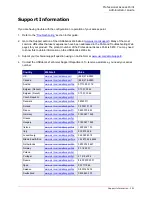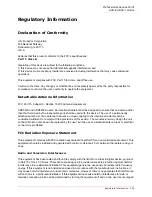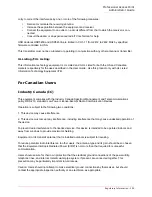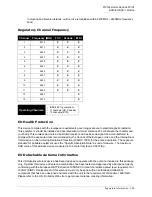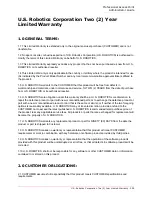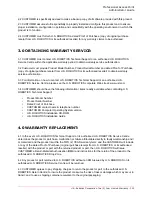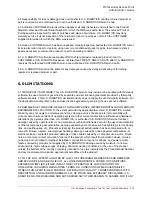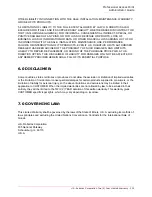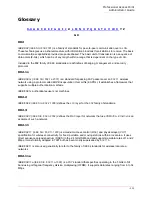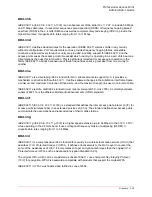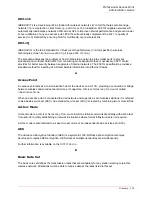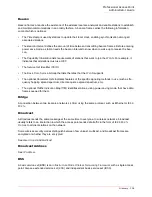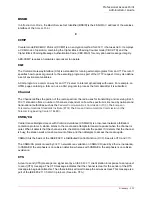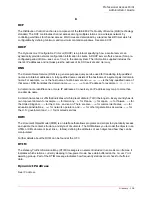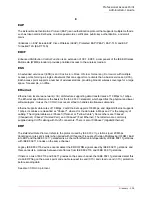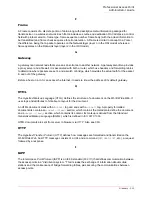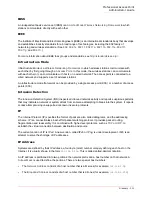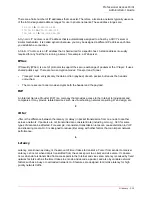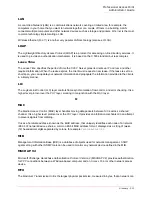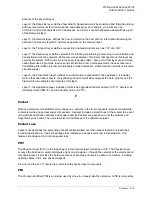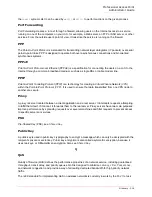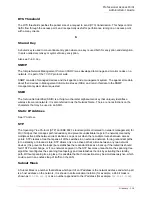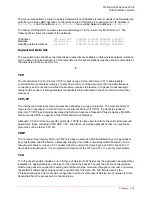
Professional Access Point
Administrator Guide
Glossary - 305
802.11k
IEEE 802.11k
is a developing
IEEE
standard for wireless networks (
WLAN
s) that helps auto-manage
network
Channel
selection, client
Roaming
, and
Access Point
utilization. 802.11k capable networks will
automatically load balance network traffic across APs to improve network performance and prevent under
or over-utilization of any one access point. 802.11k will eventually complement the
802.11e
quality of
service (
QoS
) standard by ensuring QoS for multimedia over a wireless link.
802.1Q
IEEE 802.1Q
is the
IEEE
standard for
Virtual Local Area Networks
(
VLAN
s) specific to wireless
technologies. (See
http://www.ieee802.org/1/pages/802.1Q.html
.)
The standard addresses the problem of how to break large networks into smaller parts to prevent
broadcast and multicast data traffic from consuming more bandwidth than is necessary. 802.11Q also
provides for better security between segments of internal networks. The 802.1Q specification provides a
standard method for inserting VLAN membership information into Ethernet frames.
A
Access Point
An
access point
acts as a communication hub for the devices on a
WLAN
, providing a connection or bridge
between wireless and wired network devices. It supports a
Wireless Networking Framework
called
Infrastructure Mode
.
When one access point is connected to wired network and supports a set of wireless stations, it is referred
to as a basic service set (
BSS
). An extended service set (
ESS
) is created by combining two or more BSSs.
Ad-hoc Mode
Ad-hoc mode
is a
Wireless Networking Framework
in which stations communicate directly with each other.
It is useful for quickly establishing a network in situations where formal infrastructure is not required.
Ad-hoc mode is also referred to as
peer-to-peer mode
or an independent basic service set (
IBSS
).
AES
The
Advanced Encryption Standard
(AES) is a symmetric 128-bit block data encryption technique
developed to replace DES encryption. AES works at multiple network layers simultaneously.
Further information is available on the
NIST Web site
.
B
Basic Rate Set
The
basic rate set
defines the transmission rates that are mandatory for any station wanting to join this
wireless network. All stations must be able to receive data at the rates listed in this set.
Summary of Contents for Instant802 APSDK
Page 1: ...Professional Access Point Administrator Guide R46 1224 00 rev 2 0 07 06...
Page 2: ......
Page 4: ...Professional Access Point Administrator Guide iv...
Page 8: ...Professional Access Point Administrator Guide viii...
Page 42: ...Professional Access Point Administrator Guide Basic Settings 42...
Page 52: ...Professional Access Point Administrator Guide Access Points 52...
Page 58: ...Professional Access Point Administrator Guide User Management 58...
Page 62: ...Professional Access Point Administrator Guide Sessions 62...
Page 70: ...Professional Access Point Administrator Guide Channel Management 70...
Page 88: ...Professional Access Point Administrator Guide Neighboring Access Points 88...
Page 96: ...Professional Access Point Administrator Guide Ethernet Wired Settings 96...
Page 120: ...Professional Access Point Administrator Guide Security 120...
Page 128: ...Professional Access Point Administrator Guide Virtual Wireless Networks 128...
Page 134: ...Professional Access Point Administrator Guide Radio 134...
Page 138: ...Professional Access Point Administrator Guide MAC Filtering 138...
Page 152: ...Professional Access Point Administrator Guide Quality of Service 152...
Page 160: ...Professional Access Point Administrator Guide Wireless Distribution System 160...
Page 164: ...Professional Access Point Administrator Guide Time Protocol 164...
Page 170: ...Professional Access Point Administrator Guide SNMP 170...
Page 290: ...Professional Access Point Administrator Guide Configuration Troubleshooting 290...
Page 298: ...Professional Access Point Administrator Guide Regulatory Information 298...
Page 328: ...Professional Access Point Administrator Guide Index 328...

